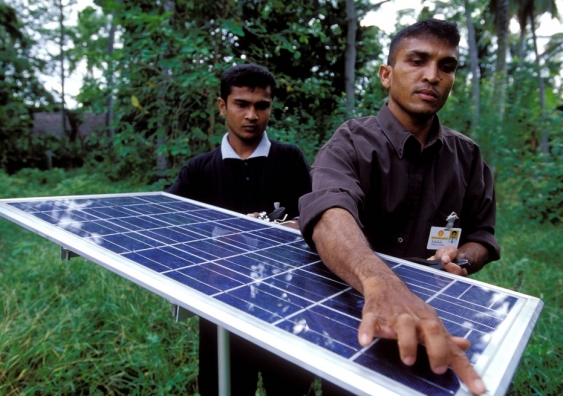How crowdfunding might secure energy access
Disruptive finance tools such as crowdfunding are capable of accelerating the deployment of off-grid solar where traditional finance mechanisms have failed, writes Andrew Blyth.
Disruptive finance tools such as crowdfunding are capable of accelerating the deployment of off-grid solar where traditional finance mechanisms have failed, writes Andrew Blyth.

OPINION: Energy poverty is a critical issue afflicting a billion people every day in developing countries where creative thinking and disruptive solutions could be the only but also the best responses. Countless communities are regularly plunged into darkness through weak power grids and the mismanagement of state-owned enterprise. Despite promising signs of economic expansion in some of these places, prospects for real change are stunted economic growth and a growing frustration of being left behind the rest of the world.
While much was made of the Prime Minister's allegedly indifferent performance at last year's G20 summit, the Australian media largely ignored his success in securing a global political commitment for more inclusive energy institutions, strengthening of energy markets, enhancing energy security, phasing out of inefficient fossil fuel subsidies, and generating support for sustainable growth and development. These landmark goals are encouraging but the challenge is improving energy access which requires what some commentators are calling a 'disruptive approach' to finance, technology and customer engagement.
How big is the problem, really? Globally, there is close to 1.5 billion people lacking access to electricity and nearly 3 billion people in rural areas of Asia and sub-Saharan Africa deprived of modern cooking energy options. The World Health Organisation (WHO) estimates that indoor air pollution caused by inefficient and inadequate cooking methods is responsible for some 1.5 million premature deaths per year, mostly women and children. With conventional approaches having approached technical, environmental and even social limits, a "revolution" in business models, technologies and policies supporting energy access is urgently needed.
The International Energy Agency (IEA) estimates the cost of providing universal energy access by 2030 will require annual investment of US$48 billion per year with much of the infrastructure required in sub-Saharan Africa. The IEA explains that some US$18 billion annually needs to be sourced from multilateral and bilateral development sources, US$15 billion from the governments of developing countries, and US$15 billion from the private sector. While the share of the global population lacking access to energy is projected to decline to 12 per cent by 2030, a billion people will still lack access to power emphasising the need for new thinking in the provision of energy.
The task of rural electrification is daunting and, given the limited public finance available in a post-GFC climate, greater effort is needed to engage the private sector in developing innovative forms of finance to devise new energy technologies for energy access, similar to the approaches being trialled to accelerate mobile phone coverage in developing countries. The current barriers to increasing private sector finance include the high costs of supplying rural area households, lack of appropriate financial incentives, weak implementing capacity and power generation shortage caused by government inaction and lack of infrastructure investment. A recent report by Bhattacharjee (2015) into rural solar lessons in Nicaragua highlights that solar is the preferred technological solution to electrifying rural villages and lessons learnt from rural off-grid solar customers can be applied elsewhere.
The key to success appears to be managing consumer expectations. It is apparent that small-scale solar home lighting and charging systems enjoy growing demand; they have cultivated an aspirational value; and most consumers are aware of improved indoor health conditions and ability to power mobile phones and radios. The report also notes the challenges arising from an inability of customers to pay, limited off-grid solar products, performance reliability, and meeting customer expectations.
One possible creative solution to disrupt traditional financing of rural electrification is crowd-sourced funding for off-grid solar. Crowd-sourced funding has shown its capacity in recent years with platforms such as IndieGoGo, Kickstarter, RocketHub and Pozible becoming increasingly accessible through the Internet. Crowdfunding has rapidly become a valuable alternative source of funding for entrepreneurs seeking external financing in various forms including equity-based, profit-sharing, lending, and donations. It is most often associated with community-based experiences that generate "community benefits" for participants while helping entrepreneurs to adopt new approaches to entrepreneurial projects and managing ventures. The scope offered by crowdsourcing leads in turn to new forms of business development in which the "ordinary" crowd gets more closely involved as active consumers, investors or both. Although the primary goal of crowdfunding is to raise money it also serves to test, promote and market products, to gain a better knowledge of consumers' tastes and create new products or services.
Early analysis suggests that disruptive finance tools such as crowdfunding are capable of accelerating the deployment of off-grid solar where traditional finance mechanisms have failed. With the right governance structures and oversight of this nascent finance tool, it is easy to imagine the good that could come from the "crowd" investing in off-grid solar in villages in rural areas of Asia and sub-Saharan Africa. While crowdfunding is an imperfect tool the potential for abuse should not prevent global leaders from promoting this bold concept given what is at stake: improving power coverage and potentially lifting a billion people out of poverty. Global leaders have committed to energy access; they now must deliver as the world is watching and wants to be involved.
Andrew Blyth is an adjunct lecturer at UNSW Canberra.
This opinion piece was first published in WA Today.